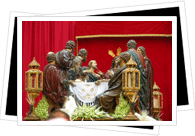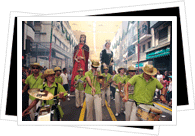When? Week leading up to Corpus Christi day (8th Sunday after Easter)
Where? El Ferial (Fairgrounds) & Granada Center
 Corpus Christi Traditions:
Corpus Christi Traditions:
While the origins of the Corpus Christi festival are undoubtedly religious, nowadays the Corpus Christi's importance as a popular "feria" very nearly eclipses the celebration's original Christian affiliation.
The Granada Feria is full of the typical light-hearted Andalucían festivities: dancing sevillanas, eating copious amounts of food, indulging in abundant quantities of wine and drink, cheering at top-notch bullfights, etc. While "casetas" are set up for this very purpose throughout the city center, the majority of the fun takes place in El Ferial, the extensive fairgrounds just on the outskirts of Granada. Plus, there's an lively annual market that sets up in the center for the duration of the Feria- definitely worth a walk-through or two!
 Not surprisingly, this co-celebration of the Granada festival and the Corpus Christi features processions- because honestly, what would an Andalucían festival be without a procession or two? The first procession is folkloric and fun, featuring costumed giants and monsters, festive music, and the appearance of "La Tarasca," a gaudily- some might even say heinously- costumed female figure who rides atop a dragon.
Not surprisingly, this co-celebration of the Granada festival and the Corpus Christi features processions- because honestly, what would an Andalucían festival be without a procession or two? The first procession is folkloric and fun, featuring costumed giants and monsters, festive music, and the appearance of "La Tarasca," a gaudily- some might even say heinously- costumed female figure who rides atop a dragon.
Three days later, on Corpus Christi Sunday, another more solemn procession- something more along the lines of what the Catholic Church had in mind- passes through the city after morning church services. The religious undertones of this second procession, in which the Eucharist is the star, are unmistakeable.
Corpus Christi History:
The celebration of the Corpus Christi, as you can well imagine, is not a modern creation. The first point on the festival's timeline is all the way back in 1208, when a 13th century Augustinian nun in Belgium apparently had several visions- somehow she interpreted images of the moon with a cloud covering half of it to mean that God was unhappy that there was no celebration of the Eucharist. A few years down the road, in 1246, the Bishop of Liège (Belgium) approved a Eucharist celebration in his diocese, which Pope Urban IV then extended to the rest of the Catholic Church in 1264.
A few centuries later, as one of the big points decided upon in the 16th century Council of Trent, it was decided that the Eucharist would be brought through the streets in an elaborate procession. During an epoch of religious instability and the growing threat of Protestantism, the Catholic Church was aiming to increase faith in the Church and in Jesus Christ. Spain, meanwhile, was in the midst of its brutal, Catholicism-based Spanish Inquisition and quickly embraced and institutionalized said celebration.